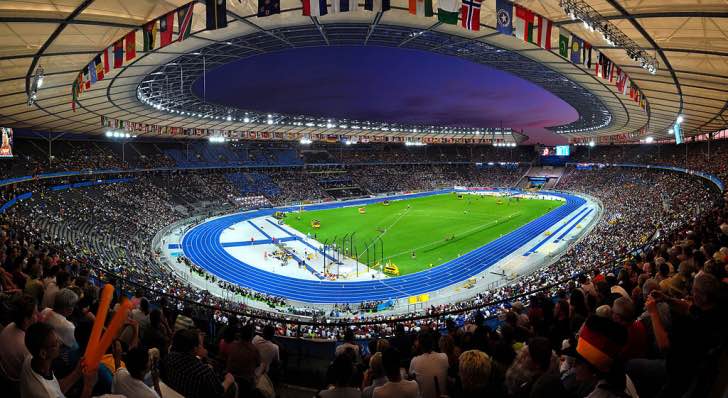Olympiastadion Berlin: Hertha Berlin
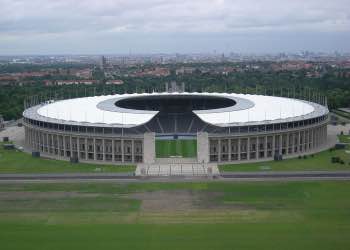
Michael Barera [CC BY-SA 4.0, CC BY-SA 3.0 or GFDL], via Wikimedia Commons
The Olympiastadion in Berlin has been the home of Hertha Berlin since 1963, though it was built for far more auspicious reasons than simply hosting football matches. We’ll tell you more about that later but, as the name of the stadium suggests, it was originally built for the Summer Olympics in 1963. During that time the capacity may well have reached over 100,000, though we haven’t included that in our records as there is no definitive proof that that was the case and it wasn’t a football match. The stadium has been used for many things over the years, being renovated in both the 1970s and after the turn of the millennium ahead of being used to host matches in the 1974 and 2006 FIFA World Cup finals.
Hertha Berlin, the club that plays its matches in the Olympiastadion, has a full title of Hertha Berliner Sport Club, though it’s more commonly referred to as Hertha BSC or simply Hertha. The club was one of the founding members of the German Football Association in 1900, having been formed itself eight years earlier. Hertha’s nickname is The Old Lady, or Die Alte Dame in German, and they’ve won two Bundesliga titles in the past. On top of that, Hertha have finished as runners-up on five separate occasions. When the club was originally formed its name was BFC Hertha 92, named after a steamship that had a smokestack with blue and white stripes on; the same colours that feature on the club’s kit.
Stats
| Olympiastadion Berlin Stats | |
|---|---|
| Year Opened | 1936 |
| Capacity | 74475 |
| Average Attendance | 50898 |
| Record Attendance | 88075 (Hertha Berlin v 1 FC Köln (1969)) |
| Pitch Size | 105 x 68(7140) |
| Former Name | Deutsches Stadion |
| Owner | State of Berlin |
| Clubs Hosted | Hertha BSC, Germany national football team |
| First Fixture | Olympic Games (1936) |
| Hertha Berlin Stats | |
|---|---|
| Year Founded | 1892 |
| Nickname | Die Alte Dame (The Old Lady) |
| Club Mascot | Herthinho (a bear) |
| Rivals | BFC Dynamo, Union Berlin |
| Previous Stadiums | Plumpe, Poststadion, Friedrich-Ludwig-Jahn-Sportpark |
| Kit | Blue & White (Home) / Dark Blue (Away) / Red (Third) |
| Training Ground | Schenkendorfplatz |
| Shirt Sponsor | AutoHero |
| Team Owner | Lars Windhorst |
| Record Goalscorer | Michael Preetz (93) |
| Record Appearances | Pál Dárdai (366) |
Olympiastadion Berlin Photos
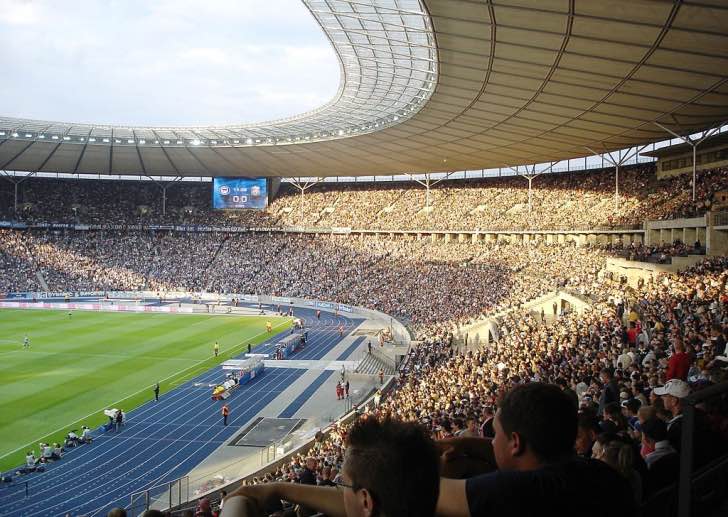
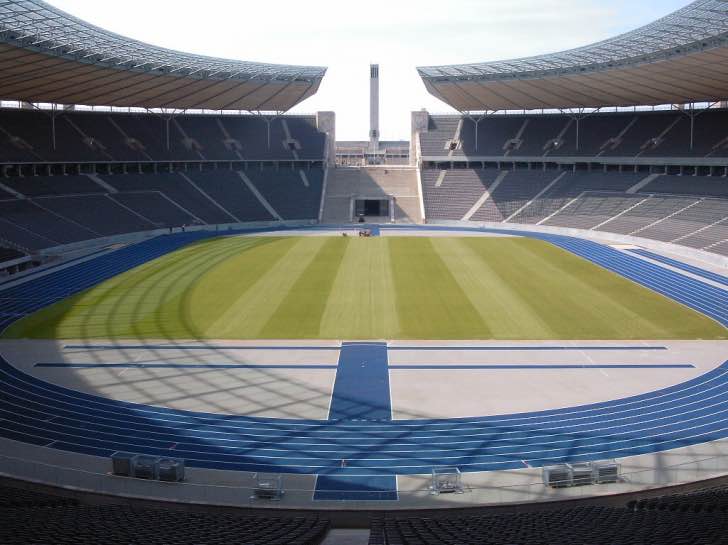
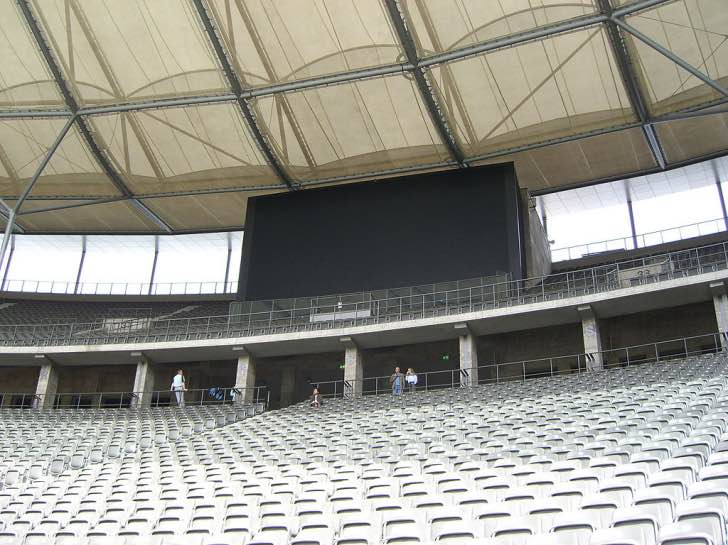
By Times (private) [GFDL
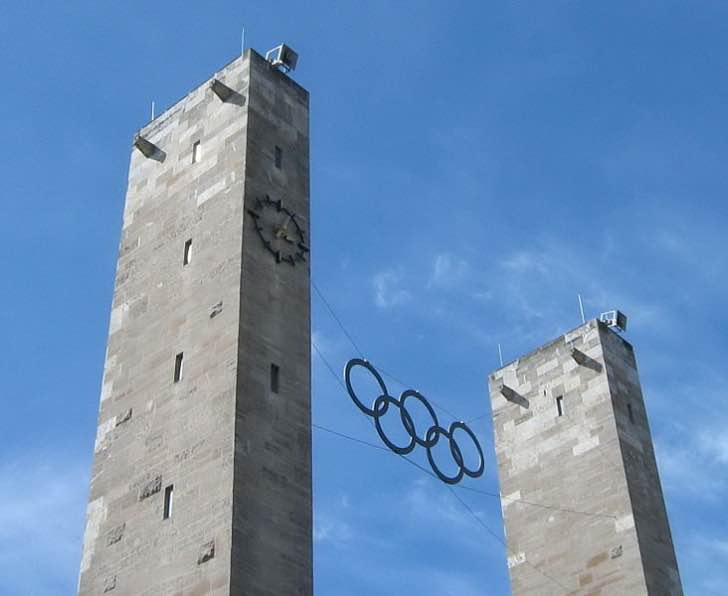
By Sir James at [1] (Own work) [CC BY-SA 3.0]
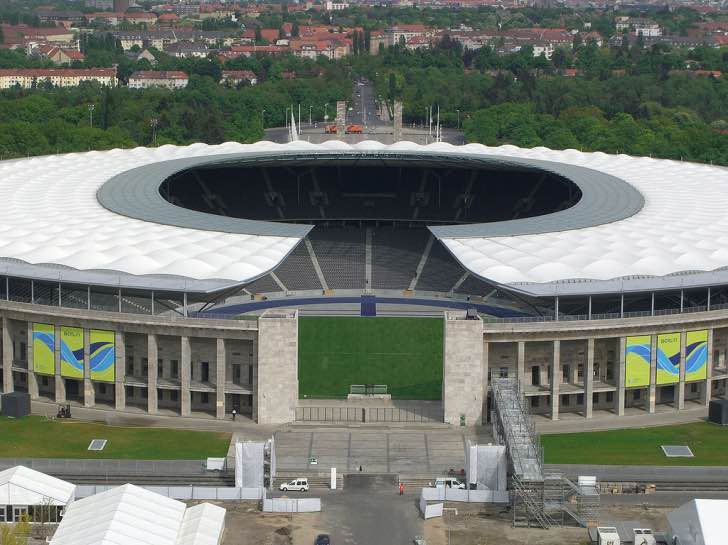
By Times (private) [GFDL
Olympiastadion Berlin Seating Plan and Where to Sit
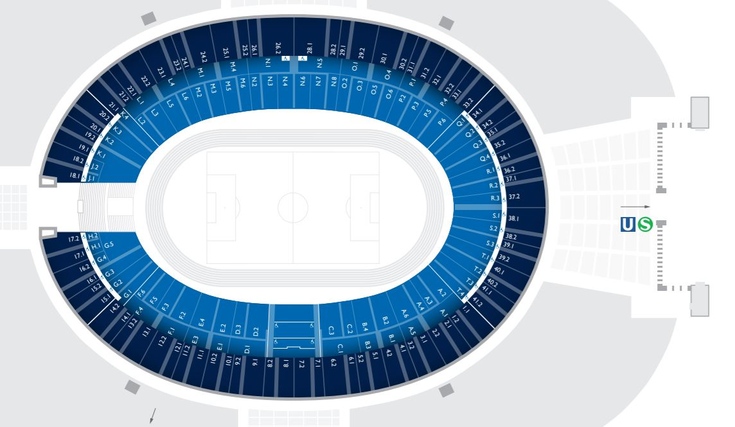
The stadium is designed as a bowl of continuous seating, as is typical on the continent. There are two tiers of seats, separated in some places by executive boxes. The seating is kept away from the pitch by a running track that goes around the entire stadium.
Hertha Berlin Ticket Prices
As is often the case with matches in Germany, prices differ depending on several factors. For starters, how old are you? Next you’ll want to think about where about inside the ground you’d like to sit and also who the game is against. For example, had you gone to see Hertha Berlin play against Athletic Bilbao in the Europa League in 2017 you’d have paid between €12 and €50 depending on your answers to those questions. If you’re entitled to money off your ticket or have a season ticket then you’ll obviously play slightly less than regular match-goers.
How To Get Hertha Berlin Tickets
Hertha Berlin’s website is a great place to head to if you want to go to see them play, with the ticket office helpful via e-mail if you need more information. You can call them directly and the staff are often able to understand English, or you can buy tickets at the box office on the day – they almost never sell out.
Where to Buy
Getting To Olympiastadion Berlin
Train – A train from London to Berlin will take about thirteen hours to complete its journey. Once you’re in the city itself it’s actually quite easy to to get to the stadium thanks to an excellent metro system. You’ll want to get either the U2 or the U12 to Olympia-Stadion, or alternatively the S5 or S75 to the same station.
Bus – If you’d rather get the bus then the M49 or 218 will take you to Flatowallee, which isn’t too far away from the ground. The 104 will take you to Neu-Westend underground station and you can either take a short tube from there or else a slightly longer walk.
Car – The A100 and A115 are the two main roads that you’ll want to get on if you’re planning on driving to the stadium before following the signs.
By Air – Berlin offers people coming in by air two major airports to choose from, starting with Tegel/Brandenburg International Airport to the North-West of the city centre. Alternatively you might want to head for Schönefeld Airport, which is about twelve miles away and tends to be used more often by budget airlines. Both are well-connected to the city thanks to the excellent German transport system.
Taxi – If you want to jump a taxi from Alexanderplatz in the city centre to the stadium then it will cost you in the region of €25 and take just over half an hour to complete its journey, depending on the traffic.
Parking Near Olympiastadion Berlin
There are over 4,000 parking spaces on site, which sounds like a lot but it’s probably not that many considering the ground can welcome more than 70,000 people. You might want to park nearby, then, or consider using the Berlin public transport.
Useful Resources
Olympiastadion Berlin Hotels
Being the capital of the country, Berlin has an abundance of places to stay – but we have narrowed it down for you.
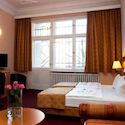
Hotel Aster - £60+
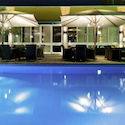
Mercure Hotel Berlin City West - £70+
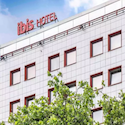
ibis Berlin Messe - £80+
Pubs and Bars Near Olympiastadion Berlin
You’re spoilt for choice in and around Berlin in terms of places to sink a few pints, put these are a few good options if you don’t fancy doing your own research.
Westend-Klause
Kings Pub
The Pub
Facilities
You won’t struggle for places to buy a beer here, and even up in the Gods the sight lines are decent. Although it can get pretty chilly in there. You can buy food (well, chips and sliced up sausage) at various places inside and outside the stadium.
Hospitality
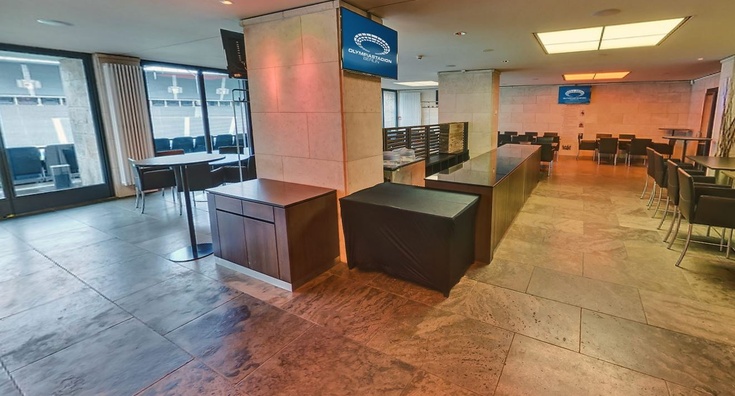
There are 59 boxes at the stadium as well as three executive lounges, so it’s fair to say that if you’re hoping to watch the match in style then you’re in luck.
Private Hire
Whether your event will have 10 people or 10,000 attending, the Olympiastadion will be able to host it. Ultra modern and with incredible facilities, there’s barely an occasion you’ll be able to think of that it won’t be able to cope with. The stadium has its own chapel too, so you’ll even be able to get married there.
Stadium Tours & Museum
There are a number of different tour options available to you depending on your budget and the amount of time you have available to you. The most basic lasts for an hour, for example, and costs from €11 up. Regardless of the tour you opt for you’ll see certain obvious parts of the stadium, starting with the dressing rooms and including the site of the pitch. Given the history of the stadium, it’s well worth doing.
About Hertha Berlin
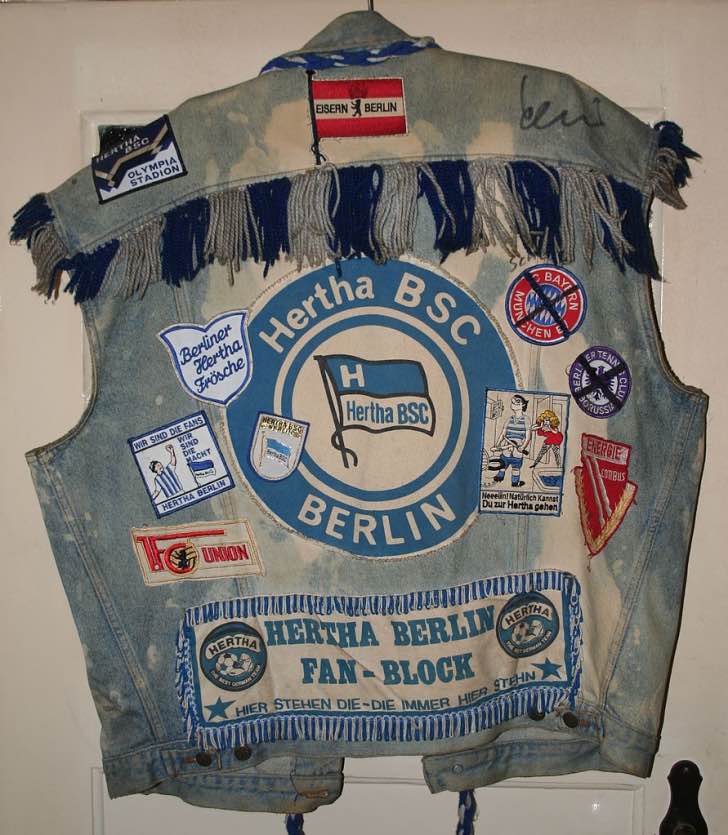
Hertha Berlin have endured some ups and downs during their history, such as when they were added to the newly formed Bundesliga in 1963 as reigning German champions, only to be relegated two years later after being found guilty of bribing players to play for them. Six years after that, in 1971, Hertha Berlin were again involved in a scandal when German clubs were involved in match fixing. The club became the symbol of a unified Berlin after the wall came down in 1989. Two days after it happened Hertha went up against SG Wattenscheid and 11,000 people from East Berlin rocked up at the Olympiastadion to watch the match with their West German friends and colleagues.
Unfortunately for Hertha BSC fans, the club has never been too far away from issues. Financial difficulties have long plagued The Old Lady, such as when it had ten million Deutsche Marks worth of debt in the middle of the 1990s. It was only during the 2010s that the club managed to restore some semblance of stability, managing to gain promotion from the Bundesliga 2 twice in three years and staying in the top-flight longer term after the second one. On top of the two Bundesliga titles we mentioned in the intro, Hertha have also picked up two DFB-Ligapokal trophies and finished as runners-up in the DFB-Pokal three times.
Olympiastadion Berlin History
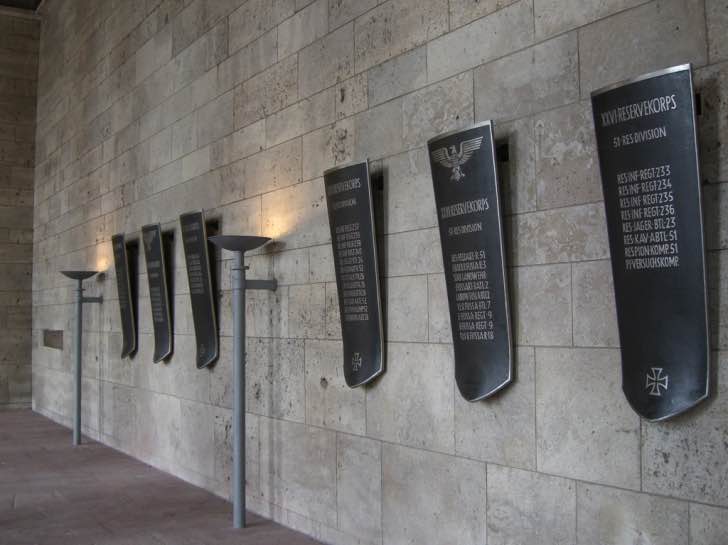
Berlin was originally selected to host the Olympics by the International Olympic Committee in 1912, but the 1916 event was cancelled due to the outbreak of the First World War. The IOC decided to appoint Berlin as the host city in 1936 instead, with the government initially deciding to restore the ground that had been built back in 1916. That all changed when the Nazis came to power and Adolf Hitler realised that he could use the games for the purposes of propaganda. Hitler demanded the building of a new Reichssportfeld, complete with a hugely impressive Olympiastadion. That’s how the original stadium ended up being built, complete with a stand especially for the Führer.
One of the most famous events in Olympic history took place at the Olympiastadion when Jesse Owens won four gold medals and, as a black man, smashed Hitler’s myth about the supremacy of the Aryan race. In the modern era the stadium has been used to host matches in two different FIFA World Cups, including three group A matches in 1974, as well as four group matches, the quarter-final and the final itself in 2006. It was the venue for the UEFA Champions League final in 2015, when Barcelona completed an historic treble that also included a La Liga title and the Copa del Rey. It has hosted countless music concerts over the years, featuring such acts as U2, Coldplay and Bruce Springsteen.
Future Developments
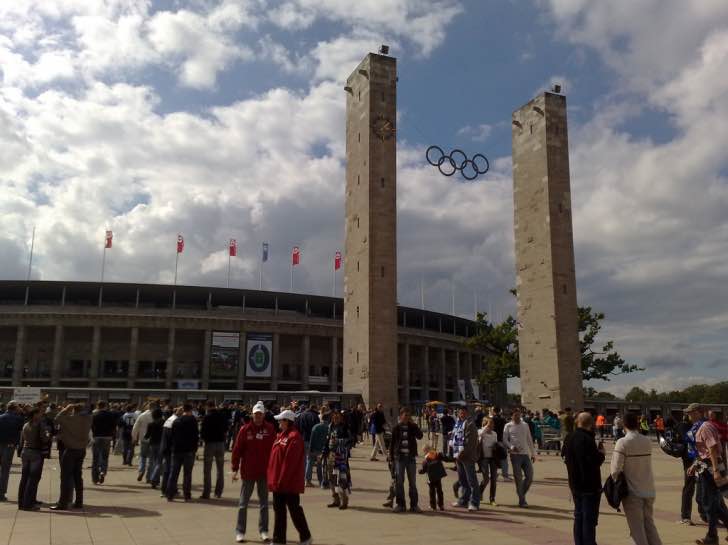
The Olympiastadion has undergone numerous renovations over the years, especially ahead of the two FIFA World Cup final tournaments it hosted. For that reason it wouldn’t be beyond the realms of the possible for it to undergo more changes in the future. That said, in March of 2017 Hertha Berlin announced plans to build a new stadium that would open in 2025, the year that the club’s contract to play at the Olympic Stadium runs out. As of yet though, no ground has been broken, so a move by that deadline is now impossible.

